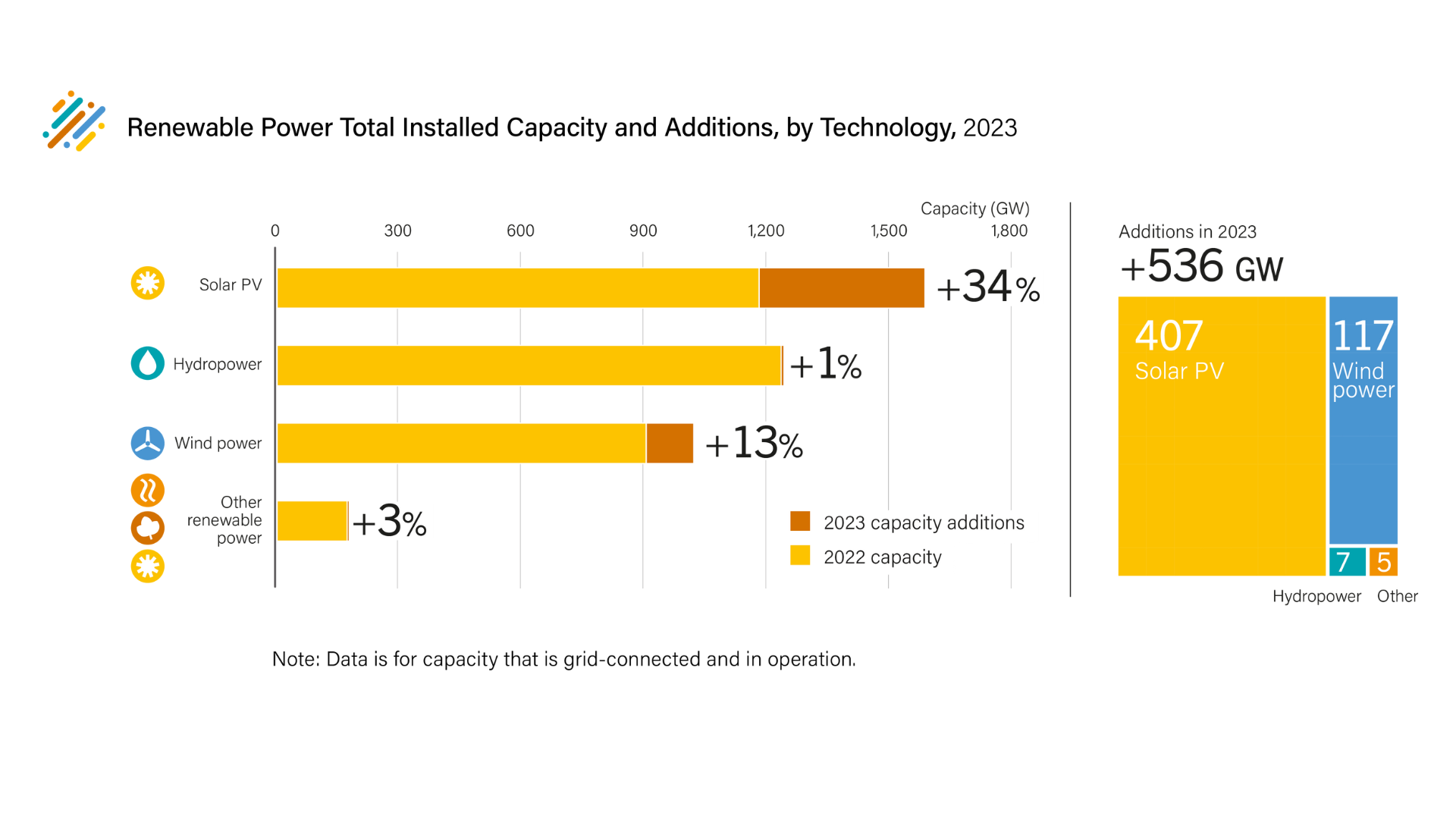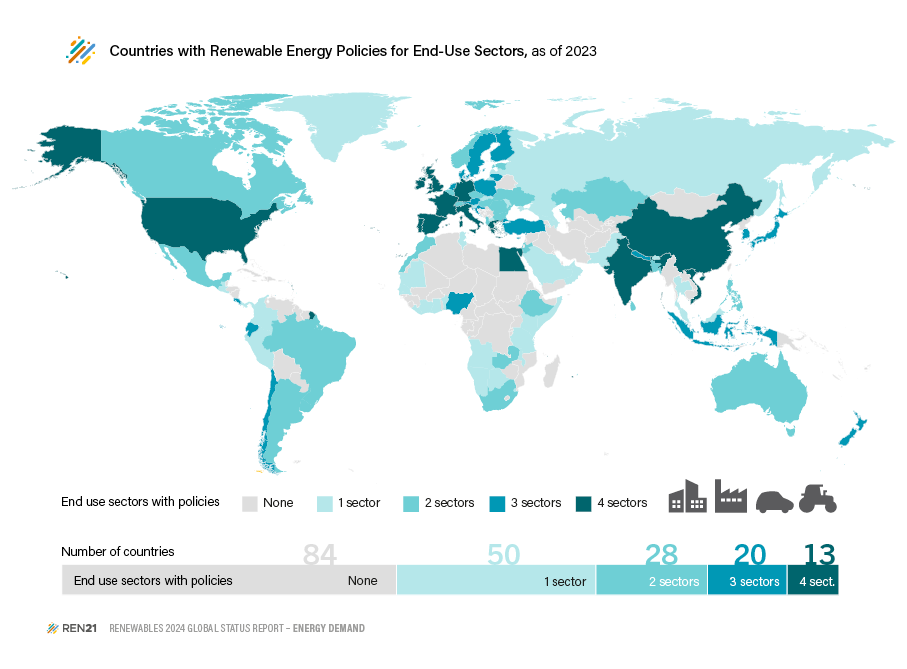The deployment of renewable energy and enabling technologies is progressing – it accounted for 7% of the growth in global GDP in 2023. However, progress remains uneven, with slower uptake in end-use sectors, persistent infrastructure challenges, and regional disparities in deployment and investment.
On this page:
Progress in the power sector; slow renewables uptake in heat and fuels sectors
The deployment of renewable energy continues to make progress, mainly in the power sector, as 30.3% of electricity is now generated from renewables. A total of 536 GW of renewable power capacity was deployed in 2023.

Heat and fuels deliver around three-quarters of total energy supply but the progress of renewables has been much slower (accounting 10% and 3.5% respectively). The policy landscape reflects this disparity: 170 countries have renewable power targets and 90 have economy-wide targets, only 43 countries have targets for heating and cooling and 46 countries have targets for biofuels.
At the same time, the world is burning more fossil fuels than ever before: fossil fuels are still heavily subsidised and dominate global energy supply with a 79% share.
“Fossil phase out, energy efficiency and renewable energy form the trinity of the energy transition. All three must go hand in hand, otherwise we will not achieve the system change needed to meet development and climate goals,” Rana Adib, Executive Director, REN21.
End-use sectors are lagging behind
Currently, only 12.7% of the energy consumed by the main four end-use sectors buildings, industry, transport, and agriculture comes from renewables. Apart from China, electrification of end-use sectors is stagnating in most countries and regions.
Although renewable energy has seen a surge in demand sectors as a response to post-pandemic recovery and geopolitical crises, policy action has lacked ambition. As of 2023, only 13 countries had implemented renewable energy policies across all end-use sectors. Targets for decarbonising end-use sectors, set by 69 countries in 2020, have largely expired, in many cases without renewal. Only 17 countries have renewed their targets or set new targets beyond 2024.

“What began as a good-news story of turning crisis into opportunity is veering in a disappointing direction. Policymakers are stuck in business-as-usual, failing to build on the success of their reactive crisis-response measures with coherent and strategic long-term policies and planning. We need to urgently realign policies to reflect the structural changes needed in the energy consuming sectors,” Rana Adib, Executive Director, REN21.
Infrastructure challenges: grid limitations, the need for energy storage and integrated planning
The renewables uptake needed to meet climate and sustainable development goals is significantly hampered by insufficient grid and storage infrastructure.
In 2022, 1.5 TW of renewable energy projects were delayed due to grid connection issues. Already strained grids are struggling to meeting growing electricity demand. To account for the increasing share of variable renewable electricity and to maintain grid stability, energy storage solutions have become crucial. Utility-scale battery increased by 120% in 2023, reaching 55.7 GW globally.
Countries like Denmark and Lithuania, which have achieved 100% renewable electricity, demonstrate that fully renewable energy systems are within reach. Yet, integrated planning and further investments in storage technologies and grid flexibility solutions, such as demand-side management, are required to ensure system reliability as renewable energy capacity grows.
“Electricity grids have been ignored far too long. Their enabling role to integrate renewable energy sources needs to be acknowledged in every country. We need to remove bottlenecks to electricity grid deployment. Building grids in harmony with nature and with people’s support is completely possible,” Antonella Battaglini, Chief Executive Officer, Renewables Grid Initiative (RGI).
Regional disparities in renewable energy deployment and investment
While 86% of global power capacity additions in 2023 came from renewables, their deployment is far from equal. China leads the world in renewable power capacity additions with the US and Europe following. Only around 18% of capacity additions took place in Asia (excluding China), Latin America, Africa, and the Middle East, even though these regions represent together nearly two-thirds of the global population. This is closely linked to the fact that investment in renewables across regions remains highly unequal. China, the US, and Europe have leading positions in new renewable power investments, while Africa and the Middle East represented not even 4% of global investments in renewables in 2023.
The global financial landscape continues to put low-income countries at a significant disadvantage, with the cost of capital for renewable energy projects reaching as high as 10%, compared with less than 4% in high-income countries. Instead of supporting developing countries’ efforts to leapfrog fossil fuels and establish renewables-based economies, this situation exacerbates inequality and prevents these countries from benefitting from the large opportunities presented by renewables.




